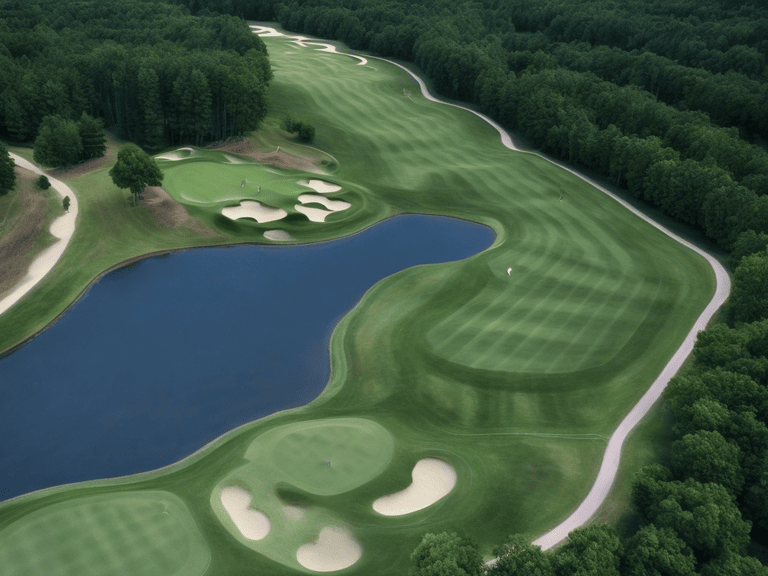Golf is a sport renowned for its unique and somewhat confusing terminology. A phrase commonly encountered during golf rounds is the term “dogleg.” If you’re a beginner or simply a little curios, you may find yourself asking: What is a dogleg in golf? In this article, we’ll explore the meaning of a dogleg and its significance in golf course design. As well as the strategies players employ when faced with this type of hole.
What Is A Dogleg?

In golf, a dogleg refers to a hole that features a significant change in direction. Typically, it involves a bend or curve in the fairway, resembling the hind leg of a dog. This unique shape requires golfers to adjust their shots accordingly to find a safe spot on the fairway. The shape of a dogleg hole can vary, resembling an “L,” “S,” or even a “U.” Although they can occasionally appear on par 3 holes as well, doglegs are most commonly found on par 4 and par 5 holes.
The Significance of Doglegs in Golf Course Design
Doglegs are commonly used in golfing design to add complexity and present a challenge to the golfer. They provide course architects with an opportunity to create interesting and diverse layouts, testing players’ skill and decision-making abilities. By incorporating doglegs, designers aim to enhance the strategic nature of the game and prevent golfers from relying solely on raw power to conquer the course.
Sometimes they may provide an opportunity for risk and reward as well. When encountering a hole that features a dogleg, particularly one that curves around water, the player has the flexibility to determine the level of risk they are willing to assume by cutting across the dogleg or corner.
In certain cases, you might try to take a shortcut across the corner of dogleg holes, even when there is no water hazard involved. For instance, if the dogleg meanders around dense rough or bushes, there could still be an opportunity to trim the distance by cutting across the corner and effectively shortening the hole.
Types Of Doglegs In Golf
A hole that turns to the right is known as a “dogleg right,” and, you’ve guessed it, a hole that turns to the left is called a “dogleg left.” The curvature of a dogleg hole can vary greatly from course to course. In some cases, there are extreme dogleg holes that make an almost 90-degree turn.
Longer holes, typically par-5s, are often referred to as double doglegs. In such holes, the fairway takes a turn in one direction, however, later along its length it curves back in the opposite direction. A.W. Tillinghast was a renowned golf course designer famous for his creation of double dogleg holes.
Strategies for Tackling Doglegs

When faced with a dogleg, golfers must carefully assess the layout and plan their shots accordingly.
Obviously, it is down to the individual player to make decisions regarding their level of aggression. If you prefer a cautious approach, you will typically opt for a straight shot using a club that enables you to reach the corner of the dogleg. This choice increases the likelihood of finding the fairway but results in a longer approach shot towards the green.
For players with an aggressive style, there is the option to embrace the challenge of matching the curvature of the dogleg. Hitting a draw or fade that gracefully bends with the direction of the dogleg is a wonderful feeling. This approach carries a higher degree of difficulty. But if accomplished successfully, it effectively reduces the hole’s length by eliminating unnecessary angles.
Conquer Doglegs: Step-By-Step
Analyzing the Shape: The first step is to identify the shape and degree of the dogleg. Because this information will help golfers determine the ideal target area and the club selection for their next shot.
Choosing the Correct Line: Golfers can choose to play a safe line by aiming for the corner of the dogleg. This offers a wider landing area but may result in a longer second shot. Alternatively, they can opt for a riskier aggressive line, attempting to carry the dogleg since this will gain a significant advantage by shortening the hole.
Club Selection: The choice of club is crucial when approaching a dogleg hole. Players must consider the distance, wind conditions, and desired landing area to select the appropriate club that allows them to position themselves favorably for the subsequent shot.
Shot Shape and Shot Placement: Skilled golfers may choose to shape their shots. To navigate the dogleg more effectively, try employing fades or draws. Proper shot placement on the fairway can set up the ideal angle for the next shot.
Summary
A dogleg in golf refers to a hole that features a significant bend or curve in the fairway. These holes are strategically designed to add complexity and challenge players’ skills. Golfers must analyze the shape of the dogleg, choose the correct line, select the appropriate club. They must also consider shot shape and placement to navigate these holes successfully. The art of conquering dogleg holes requires a blend of strategy, skill, and decision-making, making golf an intriguing and dynamic sport for players of all levels.





